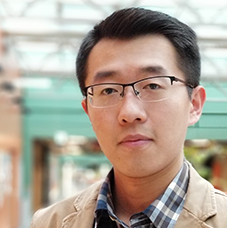Kaizheng Liu (Max)

Feel the force: cell adhesion in 3D biomimetic hydrogels
Started on February, 2020
email Kaizheng Liu (Max)
Recent developments in mechanobiology have revealed that mechanosensing is an important regulator of cell behavior. In healthy tissues, mechanical homeostasis dominates the interconnected intra- and extra-cellular stress fibers by cell adhesion to the extracellular matrix (ECM). Focal adhesions are one of the core players in this process as they connect the cytoskeleton to the ECM, transmitting mechanical forces and regulatory signals from the matrix to the nucleus. To direct (stem) cell fate in 3D culturing experiments, synthetic hydrogels with intrinsically high tunability should make ideal matrices, however, they rarely mimic the rich mechanical properties of natural ECM materials. Recently, synthetic polyisocyanopeptide (PIC)-based hydrogels were developed by Rowan/Kouwer's lab. This is the first fully synthetic material that exhibits strain-stiffening properties comparable to what is found in nature. Moreover, as it is fully synthetic, the actual material stiffness, pore size, ligand density, and ligand identity can be tightly controlled independently from each other. Because of its high structural and mechanical similarity to natural gels, this material allows us to study the influence of biochemical and mechanical properties of the ECM on cell behavior in a physiologically relevant and systematic manner. My research aims to unveil how ECM properties regulate cell-matrix interactions at the nano-scale. The results will have a high impact on tissue engineering practices and the development of new materials as artificial ECM.
Publications
Hongbo Yuan, Kaizheng Liu, Melissa JJ van Velthoven, Jyoti Kumari, Yuying Bao, Susana Rocha, Paul HJ Kouwer
Published in Nature Protocols, May 2025 (see publication in Journal )
Kaizheng Liu, Johannes Vandaele, Hongbo Yuan, Kerstin G Blank, Roel Hammink, Paul HJ Kouwer, Susana Rocha
Published in Cell Reports Physical Science, February 2024 (see publication in Journal )
Group paper
Hongbo Yuan, Kaizheng Liu, Mar Condor, Jorge Barrasa-Fano, Boris Louis, Johannes Vandaele, Paula de Almeida, Quinten Coucke, Wen Chen, Egbert Oosterwijk, Chenfen Xing, Hans Van Oosterwyck, Paul HJ Kouwer, Susana Rocha
Published in Proceedings of the National Academy of Sciences (PNAS), April 2023 (see publication in Journal or Research Gate )
Group paper
Johannes Vandaele, Boris Louis, Kaizheng Liu, Rafael Camacho, Paul H. J. Kouwer, Susana Rocha
Published in Soft Matter, March 2020 (see publication in Journal or Research Gate )
Group paper
Kaizheng Liu, Silvia Mihaila, Alan Rowan, Egbert Oosterwijk, Paul Kouwer
Published in Biomacromolecules, January 2019 (see publication in Journal )
